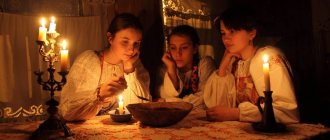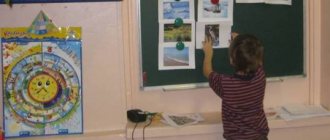Summary of a lesson on life safety for the preparatory group
Lesson for the preparatory group
Topic: “Dangerous situations: contacts with strangers on the street” Integration of educational areas: “Cognitive development” (introduction to sociocultural values: expanding the horizons of children) “Social-communicative” (formation of the foundations of safety); “Speech development” (coherent speech; introduction to fiction, “Physical development” (formation of initial ideas about a healthy lifestyle; physical education: formation of the idea that physical education movements help restore strength and relax the child’s body). Types of children’s activities: cognitive, communicative, playful, motor, perception of fiction. Goal: to form in children the desire to preserve life and their health through typical dangerous situations with possible contacts with strangers on the street. Objectives: • educational: to continue to form children’s understanding of how to properly behave in dangerous situations on a visual and verbal basis; explain to children that the pleasant appearance of a stranger does not always mean his good intentions and, conversely, an unpleasant or ugly appearance does not always mean bad intentions; teach children to observe some safety measures, developing Algorithm of behavior in an unexpected dangerous situation; • developing: develop logical thinking, ability to compare; develop interest and curiosity in children; develop coherent speech (reasoning) and the ability to briefly and accurately answer the teacher’s questions and coherently express one’s thoughts; activate children's vocabulary through words and expressions: pleasant and unpleasant appearance; stranger; danger • educational: to instill in children a positive attitude towards the rules, even if they contain a prohibitive element, since the health and safety of the children themselves will depend on this. Material: clothes for playing out dangerous situations “A stranger offers candy to a girl”, “Stranger woman” pintograms for the Didactic game “Good and Evil”; presentation “Safety rules at home and on the street.” The progress of organizing direct educational activities for children Conversation “A person’s appearance can be deceiving.” Educator: - Children, who can be dangerous to humans? Children: (Animals. Other people.) Educator: - Can people be dangerous? Children : (They can.) Educator: - Which people can be dangerous? Why? Children: (People with an unpleasant appearance. Unpleasantly dressed.) Educator: - Who is more dangerous: men or women? Children: (Men are more dangerous than women. Both women and men are dangerous.) Educator: - A stranger, be it a woman or a man, a boy or a girl, so cheerful and cheerful, can also be evil and dangerous for a child. You can meet people with bad intentions among beautiful and neat people, and vice versa, you can meet people with good intentions among ugly, unpleasant-looking people. Educator: - So, what rule do you need to know? (You shouldn’t trust a stranger on the street, even if he is outwardly attractive.) Now let’s play with you and remember the fairy-tale characters, and the game is called “Good and Evil.” Didactic game “Good and Evil” The teacher explains the rules of the game: - There are 2 hoops on the floor, in one of them there is a pictogram of an evil person, in the other there is a pictogram of a good person. On the table are images of fairy-tale characters: Baba Yaga, Koschey, Barmaley, the snake Gorynych, the Snow Queen, Wolf, Fox, Thumbelina, Cinderella, Crocodile Gena, Aibolit. Educator: - Which of these heroes can be called evil and which ones good? Children's answers: ……. Educator: - Which of them do you think can be placed at the intersection of the circles? Why? Are the fox and the wolf evil in all fairy tales? In fairy tales: “Teremok” the fox is not evil or harmful, but the wolf in the fairy tale “Sister Fox and the Gray Wolf” is kind. This means that they can be placed at the intersection of circles and we have three groups: evil, good, good-evil. What fairy-tale character do these faces resemble in shape? (pictograms). Educator: Well done, you completed the task. – Which people are close to you? Children: (Dad, mother, grandmother, grandfather, brother or sister.) Educator: - Who is your acquaintance? Children: (Apartment neighbors. Group teachers. Friends.) Educator: - Who do you consider strangers, outsiders and strangers? Children: (All those people we don’t know.) Physical education lesson The teacher plays out the situation, puts on various costumes. 1. Situation “A stranger offers candy to a girl” Teacher: – Who did I play now? Children: (A stranger tries to treat a girl with candy) Teacher: - Yes. An adult treats the child with candy, or maybe treats him to ice cream, chewing gum and other sweets. What should you do? Children: (I will refuse the treat. I will say that you cannot take sweets from strangers. I will run away from the stranger.) Educator: - Will you warn your friends about this? How? Children: (We will warn you not to take anything from a stranger.) Educator: Be careful, Dear guys: Don’t trust strangers! If they invite you to visit, Or they give you some delicious candy, It’s better to run away from them quickly And warn all your friends... 2. Situation “Stranger” The teacher dresses up as an unfamiliar woman, approaches one of the children and asks the child “where do you live?, are your parents at home, who does he live with,” etc. Educator: Whom have I portrayed now? Children: An unfamiliar woman Educator: What will you do in this situation? Children: (I’ll say that I don’t have time to talk to you. I won’t tell you this, you’re strangers to me. I’ll shout loudly: “Someone else’s aunt is pestering me!”) Educator: Well done, you coped with the task. Lesson summary Educator: In fairy tales, miracles help fight the machinations of evil heroes. In life, rules for safe communication with unfamiliar adults help you avoid troubles associated with dangerous people. Now guys, I propose to consolidate these rules “Safety rules at home and on the street.” These rules must always be followed, even if you meet a person with a pleasant appearance!
We recommend watching:
Notes on drawing for the preparatory group of a kindergarten Conversation in the preparatory group on fire safety with a presentation Conversations on life safety in the senior preparatory group of the preschool educational institution. Card index. Quiz on life safety in the preparatory group
Similar articles:
KVN on fire safety in the preparatory group
Summary of the fire safety lesson “New Year’s tree.” Preparatory group
Life safety lesson “Rules of safe behavior on water.” Preparatory group
Life safety tasks for children 5-7 years old
MAGAZINE Preschooler.RF
Sopina Elena Valerievna - teacher, MBDOU "TsRR - d/s No. 31 "Berezka" Gelendzhik, Krasnodar region. Educational area: “Safety”, “Health”, “Communication”, “Socialization”, “Reading fiction”, “Cognition”. Topic: “Every little child should know this from the cradle” Goal: To consolidate the concept of “dangerous objects” and the ability to resolve problem situations. Discuss with children various dangerous situations that may arise when playing at home or on the street. Develop the ability to protect yourself from possible dangers, develop children’s speech, and the ability to answer with complete answers. Foster a sense of self-preservation and discipline. Create a positive, emotional attitude in children.Equipment: cards with tasks, “Black Box”, pictures showing the rules (broken and not broken), cards showing first aid for a cut and bruise, chips. Progress of direct educational activities: Leader. Guys, I invite you to take part in the game “Lucky Chance”. To do this we need to split into two teams. I have a box with cards of 2 colors, please come to me and choose one card each. Whoever has red sits at the table on the left side, who has green sits at the table on the right side. And so, we have 2 teams. I suggest you come up with names for your teams and choose a captain. (Children give names to their teams.) And in order to determine which team will be stronger and more friendly, we invited a jury. Presenter: Ready for the test! Children: READY! Host: Now let's join hands and wish each other good luck. And the theme of our game is “The basis of life safety.” And today we will remember what rules must be followed. I want to remind teams that answers are accepted as long as you have your hand raised nicely. Exercise 1. "Warm-up." The main thing here is speed. In this task, I will give chips for the correct answer. At the end of the game we will add them to your points. • Small, nasty, loves dirt. (Microbe) • A device that helps you see a microbe. (Microscope.) • The part of the road along which traffic moves. (roadway.) • An animal whose name denotes a section of pavement. (Zebra.) • A device that plays an important role in regulating traffic. (Traffic light.) • The sounding instrument of a traffic police officer. (Whistle.) • The silent tool of a traffic police officer. (Rod.) • People of the heroic profession, passing through “fire, water and copper pipes.” (Firefighters.) • Model of the Earth. (Globe.) 2. Presenter: 2 minutes are given for preparation. The completeness of the answer is taken into account. The second team can complement. Often adults make comments to you that you will now hear, and you need to explain why adults make these comments to you. (We listen to the children’s reasoning and evidence.) Don’t talk while eating! Cover your mouth with a tissue when you cough! Don't look at the book lying down! Don't watch TV for too long! Don't touch the cat! Don't eat too much sweets! Stay away from the stove! Don't eat unfamiliar berries and mushrooms! 3. “Black box” (you ask me questions with which you can determine what object is in the box. I answer you only “yes” or “no”). ATTENTION is important in this task!!! I'll give you a hint: you can cook food with this item. Tip 2 - this item is not a toy for children! (Children's answers) • Is this a box of matches? - Yes. 4. “Smart guys and smart girls.” You will now see pictures in which the rules are broken and not broken, and explain them. (Show pictures). In this task, completeness of the answer, speed and accuracy are important.
5. “Rules of first aid.” Leading. Place the “action” models in the correct sequence in the expected situations. The team that completes the task first raises its hand. (The presenter hands out cards to the teams depicting first aid for a cut or bruise) 6. “Both with participants and spectators.” Leading. And now I want to test your knowledge of some more rules. And I propose to play along with the audience. The game is called “This is me, this is me, these are all my friends.” I read you a poem, if you do it correctly, then you say: This is me, this is me, these are all my friends! And raise your hands up. If this is not necessary, then you remain silent. It's clear? 1.Which of you goes forward only where there is a transition? 2. Does anyone know that a red light means there is no movement? 3.Which of you, walking home, follows the pavement? 4.Who will obey the traffic light instructions without arguing? 5.Who flies forward so fast that he doesn’t see the traffic light? 6.Who knows the rules of movement like the multiplication table? Leading. And on this cheerful note our game came to an end. I invite the jury to sum up. Everyone can find their own definition: from the most active to the most passive, from the most decisive to the most cautious.
| Next > |
Summary of educational activities with children of the preparatory group “Emergencies - what is it?”
Goal: to form an understanding of emergency situations.
Tasks:
Educational: introduce situations that can be called “emergency”, natural phenomena that cause harm to humans.
Developmental : develop the ability to find solutions in difficult situations, apply basic first aid techniques.
Educational : to cultivate a sense of mutual assistance and mutual assistance.
Progress of OOD
Slide 1
Educator: Guys, today we will talk about dangerous situations, and what should be done in such cases.
Hazards may arise due to human fault. Name them.
Children: Fire, gas explosion, flood, road accident, etc.
Educator: These are situations that arose through our fault, and they threaten one or more people. This situation includes a fire.
Slide 2, Slide 3.
Educator: What can cause a fire?
Children: From matches, from electrical appliances, from a gas stove, etc.
Slide 4.
Educator: It is imperative to know the rules of how to behave during a fire. Let's remember them.
Rules:
Let's call the adults.
If the fire is small, you can try to extinguish it immediately by throwing a thick cloth, a blanket over it, or pouring a pan of water (not on electrical appliances).
If the fire does not go out immediately, immediately run away from the house to a safe place and only after that call the fire department by phone “01” or ask your neighbors about it.
If you cannot escape from a burning apartment, immediately call “01” and tell the firefighters the exact address and number of your apartment.
After that, call neighbors and passersby for help from the window.
If you feel like you are choking on smoke, squat down or crawl towards the exit - there is less smoke below. We don’t hide under beds, tables or in corners.
When adults come to help or firefighters arrive, we obey them in everything.
Educator: Guys, there are dangerous situations that arise due to changes in natural phenomena: wind, water, snow, earth, etc. They are called emergency situations.
An emergency is a danger that threatens many people.
Name emergencies that occur due to natural changes. Questions will help you with this.
— Temporary flooding of land due to rising water. Flood.
- Very strong wind. Hurricane.
— A very strong storm at sea. Storm.
— Rapid movement of the earth's crust caused by shocks from below. Earthquake.
What emergencies happen in our city?
Children: Flood.
Slide 5.
Educator: What causes flooding?
Children: Due to heavy rains and rapid melting of snow.
Educator: As a result of the flood, houses and buildings, bridges are destroyed; erosion of railways and roads; crop destruction; people and animals die.
Educator: What structure helps the city avoid flooding? Dam.
Slide 6.
A dam is an earthen, stone or other material embankment on the bank of a river that protects the bank from flooding and serves to retain water.
Slide 7.
Actions during a flood:
Do not panic.
Collect documents, necessary things, drinking water, medicines, food supply for 2-3 days. If time permits, close the windows with shutters or boards.
Go to the upper floors of the building; in a one-story house, climb onto the roof.
Until help arrives, stay on the upper floors, roofs or other elevated areas and signal to rescuers so that they can quickly find you.
In the forest - go to an elevated place, mountain, hill, climb a tree.
If you find yourself in water, you need to swim with the flow to the nearest non-flooded area, you need to hold on to non-sinking objects floating by.
Educator: Guys, the wind can also harm a person.
Slide 8.
Our city also experiences hurricanes.
What damage can a hurricane cause?
Children: Knock down a tree, an advertisement, tear off a roof, etc.
Slide 9.
Slide 10.
Educator: If a hurricane hits and you are at home in your apartment, what should you do?
Close all windows and doors, it is better to turn off gas and electricity, and stock up on water. It is best to take shelter in the basement or in the living quarters of the first floor.
If you are outside, in the forest?
Find shelter in other durable spaces. You should understand that the car will not protect you in hurricane winds, so it is better to leave it, the wind will easily lift the car into the air.
Avoid power lines (downed power lines can be fatal to those nearby).
Avoid billboards, signs, kiosks, cars, etc. (all this can be picked up by the wind and hit you).
Stay away from isolated trees (the wind can easily knock them over).
If you couldn’t find shelter in a building, find a ditch or hole of some kind. Lie on your stomach and cover your head with your hands,
Slide 11.
Educator: Guys, rescuers always come to our aid.
This profession is considered one of the most dangerous. Rescuers come to the aid of people in trouble, often risking their own lives.
Let's play the game "We are rescuers"
Goal: to consolidate children's knowledge about the professions of the Ministry of Emergency Situations, their purpose and the availability of items that help these people in their work.
Rules of the game:
Children take turns tossing the cube. The number rolled on the die indicates the sector of the circle with the same number. The child explains why and in what situation the items depicted in this sector are intended for rescuers.
Sector 1: FOREST FIRE: a bulldozer for clearing strips of bushes and rubble, also digging in the forest so that the fire does not move further; use aircraft equipped with special containers for collecting, transporting and discharging water and fire extinguishing agents; forest fire extinguishers resemble a pump.
Sector 2: FIRE: fire extinguisher, cone bucket.
Sector 3: INCIDENT IN THE MOUNTAINS: fell into a gorge: cable, rope to reach, lift a person from the gorge, onto the mountain; helicopter, horse helps to get to the scene.
Sector 4: WHEN THE SHIP SINKED: fins, scuba gear (compressed air tank, snorkel), wetsuit.
Sector 5: FLOOD: life jacket, ring, boat.
Sector 6: EARTHQUAKE, AVALANCHE, DEBACLE, EXPLOSIONS: search dog, stretcher, shovel.
Educator: In order for a rescuer to cope with his work, he must be strong and resilient. Rescuers do a lot of sports and train. Now we will hold competitions for young rescuers.
Relay race “Who will sound the alarm faster?”
From the starting point, the participant runs to the cube on which the triangle lies, gives a signal (rings the triangle) and runs back. Passes the baton to the next one.
Relay race “Sorting out rubble”
The explosion destroyed the house. Rescuers need to quickly clear the rubble.
A child with a toy car “drives up” to a “destroyed house.” He puts one “brick” in the back of the car and takes it to a certain place. Passes the baton to the next one.
Relay race "First aid"
Very often in emergency situations, assistance is needed for weaker or injured people. Rescuers must come to the aid of the victims and provide medical assistance.
Educator: Today we got acquainted with natural disasters, remember the danger and always follow the safety rules!







